Physical Address
304 North Cardinal St.
Dorchester Center, MA 02124
Intraoperative pathology consultation with or without frozen section analysis is commonly used during surgery performed for a variety of diseases involving the upper gastrointestinal (GI) tract. It can be requested to determine completeness of cancer resection (margin status), assess extent of cancer, diagnose a mass or lesion when preoperative mucosal biopsy is inconclusive, or diagnose incidental lesions encountered intraoperatively. Timely and direct communication with the surgeon is essential to optimize intraoperative consultation (IOC) and assure the best outcome for the patient. This chapter is divided into two parts according to anatomic site: esophagus and stomach.
Common indications for intraoperative pathology consultation for esophageal surgery are summarized in Table 10-1 .
|
Esophagectomy remains the cornerstone of curative treatment for patients with cancer of the esophagus and esophagogastric junction. Preoperative evaluation of the cancer by esophagoscopy and biopsy establishes the diagnosis, and preoperative evaluation by positron emission tomography (PET), computed tomography (CT), and endoscopic ultrasound (EUS) provides clinical cancer stage (cStage) (Li and Rice, 2012). Intraoperative frozen section may be requested to determine if abnormalities found at surgical exploration are foci of distant metastatic cancer (M1, pStage IV). Such examples include lesions identified on the pleural or peritoneal surfaces, small lesions found during examination of the lungs or liver, or nonregional lymph nodes suspicious for metastasis. The surgeon may biopsy these abnormalities and request frozen sections to direct surgery. The histopathologic diagnosis is usually straightforward if malignant glands and cells are present ( Figure 10-1 ). However, caution should be taken to rule out benign lesions such as entrapped lung parenchyma with reactive pneumocyte atypia (diaphragm lesions) and bile duct hamartoma or peribiliary gland hamartoma (bile duct adenoma) that are typically superficial liver lesions ( Figure 10-2 ). If there are distant metastases at frozen section, the surgeon will typically abort the planned esophagectomy.
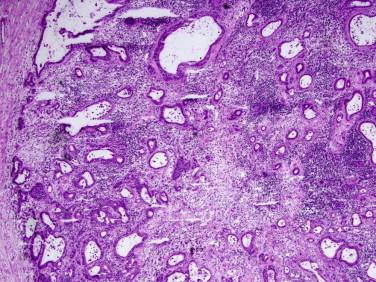
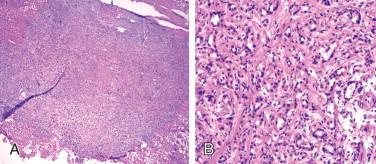
Very rarely, a surgeon may request frozen section of a resected or biopsied regional lymph node. The pathologist must be aware of the location of the node. Regional lymph nodes are periesophageal in location (in the bed of resection), extending from cervical nodes at the cricopharyngeus to celiac nodes. The surgeon may still carry on with the planned esophagectomy despite presence of regional nodal metastasis (pN +, pStage III); however, in the case of nonregional lymph node metastasis (M1, pStage IV), the planned esophagectomy will probably be abandoned.
In the United States, many esophagectomies are performed for Barrett esophagus (BE)–associated adenocarcinoma. The diagnosis of cancer is almost always made preoperatively at esophagoscopy and biopsy. Thus the IOC is often requested solely for determining margin status of the esophagectomy specimen. Handling of the distal margin will require an understanding of the reconstruction being planned. If the surgeon performs a generous gastric resection, forming a gastric “tube” for reconstruction, the gastric portion of the esophagectomy specimen is typically generous, and the gastric margin is often far enough from the cancer that macroscopic evaluation of the gastric margin is adequate. It has been reported that if the grossly visible cancer is at least 5 cm from the closest gastric margin, a macroscopically negative gastric margin is predictive of a microscopically negative margin (Casson et al, 2000). However, if gastric resection is performed in an attempt to preserve proximal stomach so as to use “full” stomach for reconstruction, a frozen section analysis of the distal gastric margin is recommended.
The proximal margin will be affected by the level of planned esophagogastric anastomosis and length of the Barrett segment. If a low intrathoracic anastomosis is planned, particularly if there is a long segment of Barrett esophagus, the length of the uninvolved esophageal portion in the esophagectomy specimen may be short and potentially inadequate, mandating frozen section of the proximal margin. If a cervical anastomosis is planned, a gross examination of the proximal margin may be all that is required, particularly if the Barrett segment is relatively short. However, presence of grossly normal squamous mucosa in the proximal margin does not always predict a negative margin because sometimes cancer can extend underneath an otherwise unremarkable squamous mucosa (Kuwano et al, 2002) ( Figure 10-3 ). In addition, pagetoid spread of adenocarcinoma along the squamous epithelium, which may potentially involve the proximal resection margin, has been reported (Abraham et al, 2008) ( Figure 10-4 ). As a result, a microscopic assessment of the proximal margin should be performed by frozen section.
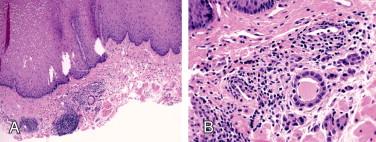
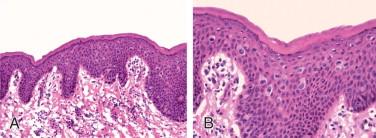
Depth of tumor invasion (T classification) greatly affects the length of grossly uninvolved (negative) esophagus necessary to ensure a microscopically negative margin. Because a significant number of esophagectomies are performed for early BE-associated adenocarcinoma, the length of grossly negative esophagus may not need to be as long as that required for a more deeply invasive cancer. However, untreated, medically treated, and endoscopically ablated Barrett mucosa can be variably associated with buried BE and BE-associated neoplasia (Ban et al, 2004; Shaheen et al, 2009). Use of intraoperative frozen section to ensure complete resection of Barrett mucosa may be justifiable.
For an esophagectomy specimen harboring BE-associated adenocarcinoma, an IOC of the resection margins can be processed as described in Table 10-2 , evaluated as in Table 10-3 , and reported as in Table 10-4 . An example of negative margin is shown in Figure 10-5 . Of note, frozen sections of the proximal margin should also be evaluated for the presence of BE and BE-associated dysplasia, even if it is negative for invasive cancer. Presence of BE and/or BE-associated dysplasia ( Figure 10-6 ) at the proximal margin may prompt the surgeon to resect additional esophagus to obtain a margin of squamous epithelium.
|
| Features | Negative Margin | Positive for Carcinoma | Positive for BE or BE-Dysplasia |
|---|---|---|---|
| Normal squamous Normal submucosa Normal muscularis propria Normal adventitial tissue Glandular structure beyond the mucosa Intestinal metaplasia Dysplastic glands Solid sheets or clusters of atypical cells Infiltrating individual or signet ring cells Acellular mucin Tumor necrosis Perineural invasion Lymphovascular invasion |
+++ +++ +++ +++ +/- (bland and round/lobular glands in submucosa) - - - - + - - - |
+ +/- |
+/- +++ +++ +++ +/- (bland and round/lobular glands in submucosa) + +/- - - + - - - |
 |
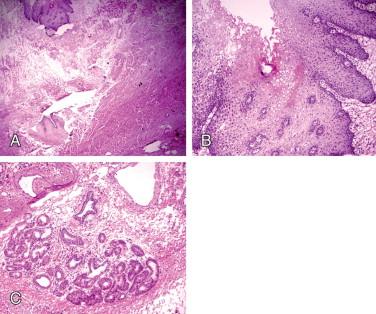
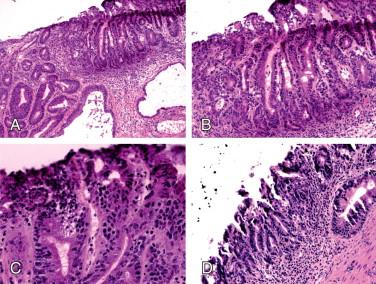
Intraoperative consultation for margin status at esophagectomy performed for squamous cell carcinoma is often requested by the surgeon. It has been shown that at least 3 cm of grossly negative esophageal margin from the proximal cancer edge is predictive of a microscopically negative margin (Tsutsui et al, 1995). However, esophageal squamous cell carcinoma can be multifocal, and thus gross examination only of the proximal margin may be unreliable. Therefore the proximal margin of a squamous cell cancer esophagectomy specimen should be submitted for frozen section and examined histologically for the presence of invasive cancer and dysplasia. The distal gastric margin can be reported as grossly negative by visual inspection alone in situations when the distance from the cancer is generous, when esophagectomies are performed for upper or middle thoracic squamous cell cancers, and when a large gastric resection is performed to produce a gastric tube.
Evaluation of the radial (deep, circumferential, or adventitial) margin of esophagectomy specimens (either for adenocarcinoma or squamous cell carcinoma) is usually not requested or performed as IOC because surgeons typically rely on their ability to ensure a negative resection margin. If there is clinically suspected invasion of adjacent structures that is resectable (pT4a), the radial margin should be marked by the surgeon for later permanent pathologic evaluation. Histologically involved radial margin (defined as either tumor cells present at or within 1 mm of the radial margin) is associated with higher frequency of local tumor recurrence and predicts worse patient survival (Sagar et al, 1993; Dexter et al, 2001). If there is invasion of adjacent structures that is potentially unresectable (pT4b), frozen section examination of this margin may help in the decision to abort a planned esophagectomy.
If a radial margin is requested, it must be remembered that preparation of the specimen by either the surgeon or the pathologist requires preservation of the radial margin. A falsely positive margin will result if the periesophageal tissue is cleared in an attempt to identify the margin or maximize lymph node analysis.
Intraoperative interpretation of esophageal resection margins can be challenging (Chatelain et al, 2012). Reasons for IOC errors include difficulties in specimen sampling and technical and interpretive problems (White and Trotter, 2008) ( Table 10-5 ). Sampling and technical errors should be minimized by taking a complete full-thickness rim of the margin and performing histologic evaluation on a full-thickness frozen section. Additional sections deeper into the frozen block should be cut when the initial frozen section diagnosis is inconclusive. Interpretive difficulties include signet ring cell morphology, chemoradiation atypia, and cautery artifacts. In case of signet ring cell carcinoma, review of the preoperative biopsy slides may prove helpful in avoiding this interpretive error. Preoperative chemoradiation therapy is increasingly used to treat esophageal carcinoma before esophagectomy; in such cases, chemoradiation atypia at the resection margins can be mistaken for dysplasia or even invasive carcinoma, leading to unnecessary additional resection. While certain features help differentiate true dysplasia/neoplasm from radiation atypia, clinical history remains the key. In cases with uncertainty, the pathologist should inquire whether the patient had preoperative chemoradiation therapy and may show the frozen section slides to another pathologist, prior to declaring that cancer is present at the margin.
| Errors or Difficulties | Ways to Minimize the Errors |
|---|---|
| Sampling error | Submit a complete and full thickness of tissue rim and take two full-thickness frozen sections Additional sections if the diagnosis is inconclusive on the first two frozen sections |
| Signet ring cell morphology | Retrieve biopsy slide containing the tumor Pay attention to high cellularity, nuclear hyperchromasia and pleomorphism, infiltrative growth pattern, desmoplasia, lymphovascular and perineural invasion Seek opinion from another pathologist |
| Chemoradiation atypia | Clinical history of chemoradiation is the key Histologic clues: atypical stromal cells, vascular abnormality (intimal hyperplasia, luminal obliteration) Low cellularity of and low N/C ratio in atypical cells, smooth nuclear membrane, lack of true pleomorphism Seek opinion from another pathologist |
Become a Clinical Tree membership for Full access and enjoy Unlimited articles
If you are a member. Log in here